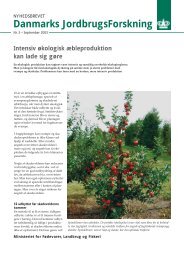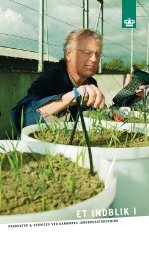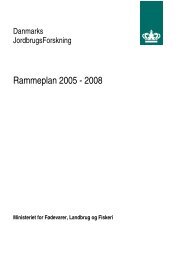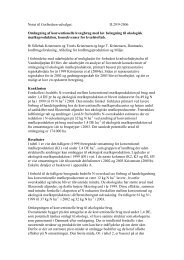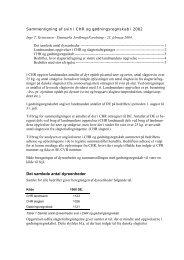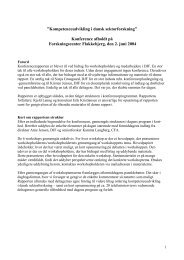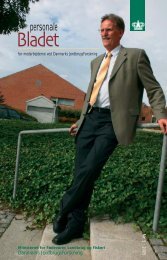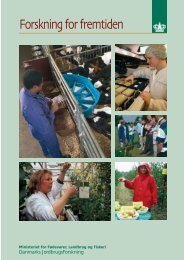Reproduction performances and conditions of group-housed non ...
Reproduction performances and conditions of group-housed non ...
Reproduction performances and conditions of group-housed non ...
Create successful ePaper yourself
Turn your PDF publications into a flip-book with our unique Google optimized e-Paper software.
- Paper I -<br />
less time spent at the trough (Andersen et al., 1999). This indicate that <strong>group</strong> <strong>housed</strong> sys-<br />
tems without individual feeding can lead to individual variation in feed intake between<br />
sows. However, even in <strong>group</strong> <strong>housed</strong> systems with individual feeding, such as ESF, lower<br />
feed intake in the low <strong>and</strong> middle ranking sows has been indicated (Mendl et al., 1992).<br />
The reason for this might be that the low <strong>and</strong> middle ranking sows do not always eat the<br />
ration allocated because <strong>of</strong> intimidation from sows waiting outside the feeder (Mendl et al.,<br />
1992). Furthermore, experiences from practice show that high ranking sows visit the feed<br />
station several times to lick feed left over, this may make it more difficult for the low ranking<br />
sows to gain access to the feed station (Olsson & Svendsen, 1997).<br />
Sows are <strong>of</strong>ten fed ad libitum or close to ad libitum before mating (flushing) in commercial<br />
practice. In Denmark, for instance, recommendation for energy supply, in the period from<br />
weaning to mating, is 51-77 MJ ME day -1 (The National Committee for Pig Production,<br />
2003a). When feed is provided ad libitum during pregnancy, the low ranking sows have<br />
been found to have comparable feed intake with higher ranking individuals (Brouns & Edwards,<br />
1994). However, in herds with <strong>group</strong> <strong>housed</strong> <strong>non</strong>-lactating sows, the sows are usual<br />
mixed with unfamiliar sows after weaning <strong>and</strong> when unfamiliar sows are mixed, fighting<br />
occur until a hierarchy is established (Arey & Edwards, 1998). Mixing with unfamiliar<br />
sows seems to be a stressful condition with increased level <strong>of</strong> plasma cortisol as a consequence<br />
(Barnett et al., 1981; Dalin et al., 1993; Tsuma et al., 1996) especially for the sows<br />
receiving most aggressions (Mendl et al., 1992). The effect <strong>of</strong> stress upon appetite in pigs<br />
has not yet been studied as far as we know. However, there are indications that stress may<br />
reduce appetite in rats (Rodríguez Echanía et al., 1988; Ottenweller et al., 1989). It is therefore<br />
likely that sows involved in many fights will have reduced appetite <strong>and</strong> therefore reduced<br />
feed intake even though the feed is provided ad libitum.<br />
In commercial practice, pregnant sows are usual fed amounts far below their capacity for<br />
feed intake (Brouns et al., 1991). Therefore, pregnant sows are motivated to eat throughout<br />
the day (Jensen et al., 2000) <strong>and</strong> competition for food is a major cause <strong>of</strong> aggressions in<br />
<strong>group</strong> feeding systems (Olsson et al., 1993). As mentioned above, there are indications that<br />
this may lead to an uneven energy intake in low <strong>and</strong> high ranking sows during pregnancy.<br />
For the above-mentioned reasons, it is believed that individual variation in energy supply is<br />
likely to occur in <strong>group</strong> housing systems both before mating <strong>and</strong> in pregnancy. It is generally<br />
agreed that energy intake can influence reproduction related processes in the female pig<br />
(Einarsson & Rojkittikhun, 1993; Cosgrove & Foxcr<strong>of</strong>t, 1996; Foxcr<strong>of</strong>t, 1997; Prunier &<br />
Quesnel, 2000ab). Therefore, one reason for the lower litter size <strong>and</strong> pregnancy rate in<br />
<strong>group</strong> <strong>housed</strong> sows compared to individual <strong>housed</strong> sows seen in some on-farm studies<br />
could be individual differences in energy intake between sows.<br />
24




